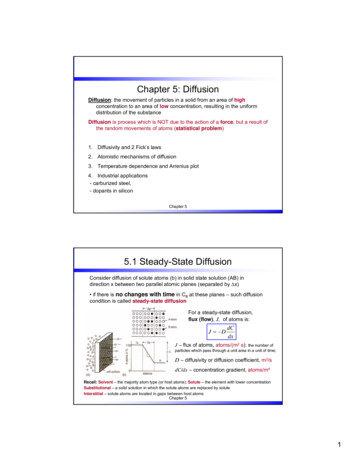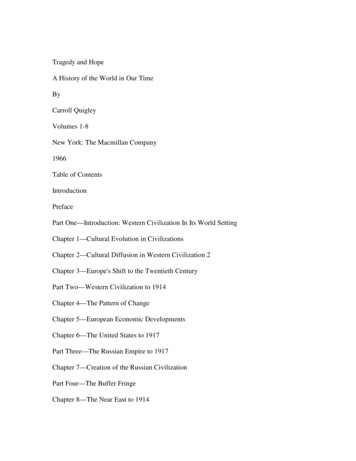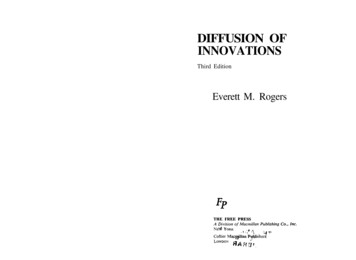
Transcription
Chapter 5: DiffusionDiffusion: the movement of particles in a solid from an area of highconcentration to an area of low concentration, resulting in the uniformdistribution of the substanceDiffusion is process which is NOT due to the action of a force, but a result ofthe random movements of atoms (statistical problem)1. Diffusivity and 2 Fick’s laws2. Atomistic mechanisms of diffusion3. Temperature dependence and Arrenius plot4. Industrial applications- carburized steel,- dopants in siliconChapter 55.1 Steady-State DiffusionConsider diffusion of solute atoms (b) in solid state solution (AB) indirection x between two parallel atomic planes (separated by x) if there is no changes with time in CB at these planes – such diffusioncondition is called steady-state diffusionFor a steady-state diffusion,flux (flow), J, of atoms is:J DdCdxJ – flux of atoms, atoms/(m2 s): the number ofparticles which pass through a unit area in a unit of time;D – diffusivity or diffusion coefficient, m2/sdC/dx – concentration gradient, atoms/m4Recall: Solvent – the majority atom type (or host atoms): Solute – the element with lower concentrationSubstitutional – a solid solution in which the solute atoms are replaced by soluteInterstitial – solute atoms are located in gaps between host atomsChapter 51
Fick’s first law of diffusionJ DdCdxFor steady-state diffusion condition (no change in thesystem with time), the net flow of atoms is equal to thediffusivity D times the diffusion gradient dC/dx m 2 dC atoms 1 atoms J 2 D 3m m s s dx m‘-’ sign: flux direction is fromthe higher to the lowerconcentration; i.e. it is theopposite to the concentrationgradientDiffusivity D depends on:1. Diffusion mechanism2. Temperature of diffusion3. Type of crystal structure (bcc fcc)4. Crystal imperfections5. Concentration of diffusing speciesChapter 5Non-Steady-State DiffusionIn practice the concentration of solute atoms at any point inthe material changes with time – non-steady-state diffusionFor non-steady-state condition, diffusioncoefficient, D - NOT dependent on time:Second Fick’s law of diffusion:If D D(x), in 1D case:In 3D case:dC x d dC x D dtdx dx 2CdC x D 2 xdtChange in concentration in 2 semi-infiniterods of Cu and Ni caused by diffusion, FromG. Gottstein “Physical Foundations ofMaterial Science”The rate of compositional change is equal tothe diffusivity times the rate of the change ofthe concentration gradient 2C 2 C 2 C dC x D 2 2 2 y z dt xChapter 52
Non-Steady-State Diffusion (continued)With specific initial or boundary conditions this partial differential equations can be solvedto give the concentration as function of spatial position and time c(x, y, z, t)Let us consider two rods with different concentrations c1and c2 which are joined at x 0 and both are so long thatmathematically they can be considered as infinitely longThe concentration profile at t 0 is discontinuous at x 0:x 0, c c1; x 0, c c22We can obtain solution of: dC x D C2 xdtc( x, t ) c1 c2 c1where erf ( z ) xz 2 Dtπx2 Dt e ξ dξ 2 2πz e ξ 2c2 c1 x 1 erf 2 2 Dt dξ , is known as the error function0Chapter 5Gas diffusion into a solidLet us consider the case of a gas A diffusing into a solid BGas ASolid BCs C x x erf C S Co 2 Dt x 0CS – surf. C of element in gas diffusing into thesurfaceCo – initial uniform concentration of element insolidx - distance from surfaceD – diffusivity of diffusing solute elementt – timeerf – mathematical function called error functionChapter 53
Error functionCurve of the error function erf (z) forz x2 DtChapter 5Q: Consider the gas carburizing of a gear of 1018 steel (C 0.18 wt %) at 927 C. Calculate the timenecessary to increase the C content to 0.35 wt % at 0.40 mm below the surface of the gear. Assume the Ccontent at the surface to be 1.15 wt % and that the nominal C content of the steel gear before carburizing is0.18 wt %. D (C in γ iron) at 927 C 1.28 10-11 m2/sChapter 54
5.2 Atomistics of Solid State Diffusion Diffusion mechanisms:1. Vacancy (substitutional) diffusion – migration of atom in a lattice assistedby the presence of vacanciesEx.: self diffusion of Cu atoms in Cu crystal2. Interstitial diffusion – movement of atoms from one interstitial site toanother neighboring interstitial site without permanent displacement any ofthe atoms in the matrix crystal latticeEx.: C diffusion in BCC ironChapter 5VacanciesThe simplest point defect is the vacancy (V) – an atom site from which anatom is missingVacancies are always present; their number NV depends on temperature (T)NV N e EVkTNV - # of vacanciesN - number of lattice sitesEV – energy required to form a vacancyk – Boltzmann constantk 1.38 10-23 J K-1; or 8.62 10-5 eV K-1T – absolute temperaturevacancyChapter 55
Vacancy (Substitutional) Diffusion MechanismSubstitutional (in homogeneous system - self-diffusion,in heterogeneous system – solid state solutions) Vacancies are always present at any T As T increases # of vacancies increases diffusion rate increases Move atom A (from (1) to (2)) move vacancy from(2) to (1).?higher Tmelt stronger bonding between atoms high activation energy to move VChapter 5Kirkendall effect Marker at the diffusion interface move slightly in the opposite direction to themost rapidly moving species vacancies can move!Chapter 56
Possible mechanisms of self-diffusion and theiractivation energy1.2.3.4.5.Neighboring atoms exchange sitesRing mechanismVacancy mechanismDirect interstitial mechanismIndirect interstitial mechanismMigration FormationTotal18 eV-8 eV31 eV1 eV2 eV40.6 eV3.4 eV4 eV60.2 eV3.4 eV3.6 eVChapter 5Anisotropy EffectsFrom G.Gottstein “Physical Foundations of Material Science”Chapter 57
Carbon diffusion in FeJump frequency Γ [s-1] of an atom is given by:Γ ν e GmkTUsually ν 1013 [s-1] vibrational frequency of the atomThere is a fundamental relationship between the jumpfrequency Γ and the diffusion coefficient D which isindependent of mechanism and crystal structure:D λ26 Γ J JMN - JNMλ26τλ – the jump distance of the diffusing atomτ 1/Γ – the time interval between two jumps1 21 2J CMA Γ C NA Γ 4 34 3D Γa 224Chapter 5Carbon diffusion in FeCan be derived from an atomistic considerations of thediffusion processesC atoms are located on the octahedral interstitial sites(black circles)J JMN - JNMOnly ¼ of possible jumps of C atoms lead to flux in xOnly 2/3 of all C atoms can jump in x directionD λ26 Γ D λ26τΓa 224Chapter 58
5.3 Effects of T on diffusion in solids Diffusion rate in a system will increase with temperature:D Do e EARTD – diffusivity, m2/sD0- proportionality constant, m2/s, independent of TEA – activation energy for diffusing species, J/molR – molar gas constantR 8.314 J mol-1 K-1; or 1.987cal mol-1K-1T – absolute temperatureChapter 5Activation energyA B C DA (initial state) A* (final state) only a fraction of the molecules or atoms in a system will havesufficient energy to reach E* A thermally active process is one which requires a definite amountof thermal energy to overcome an activation energy barrier and enterthe reactive stateChapter 59
Bolzmann’s equation On the basis of statistical analysis, Bolzmann’s results showed that theprobability of finding a molecule or atom at an energy level E* the averageenergy E of all the molecules or atoms in a system at a particulartemperature T, K, was:Probability e where kB 1.38 10-23 J/(atom K) Boltzmann’s constantE* EkTThe fraction of atoms or molecules in a system having energies E* at agiven T (where E* is much greater than the average energy of any atomor molecule:nN total C e E*kTChapter 5Arrhenius Rate EquationThe rate of many chemical reaction as a function of temperature as follows:Rate of reaction C e EARTC – rate constant, independent of TEA – activation energyR – molar gas constantR 8.314 J mol-1 K-1; or 1.987cal mol-1K-1T – absolute temperatureChapter 510
Typical Arrhenius PlotIf we rewrite in natural log plot:ln rate ln C ln rate aln C b1x TEARTy b m xor in logarithmic log plot:log10 rate log10 C EA2.303RTChapter 5Q.: The diffusivity of Ag atoms in solid silver metal is 1.0X1017 m2/s at 500oC and 7.0x10-13 m2/s at 1000oC.Calculate the activation energy (J/mole) for the diffusion of Ag in Ag in the T range 500 to 1000oC.Chapter 511
5.4 Industrial applicationsSteel Hardening by Gas CarburizingIn the gas carburizing process for steel parts, the parts are placed in afurnace in contact with a gas rich in CO-CH4 mixture at 927ºC.Fe x CH4 FeCx (x 0.1-0.25% C), T 927oC The C from the gas diffuses into the surface of the steel part andincreases the C content of the outer surface region of the part.The higher C concentration at the surface makes the steel harder inthis regionA steel part can thus be produced with a hard outer layer and atough low C steel inner core (important, for example, for many typesof gears)Chapter 5Dopants activationDopants can be incorporated into Si wafer to change their electrical conductingcharacteristicsB, P Ion implantationmaskAnnealingChapter 512
Q: If boron, B, is diffused into a thick slice of Si with no previous B in it at a temperature of 1100 C for 5 h,what is the depth below the surface at which the concentration is 1017 atoms/cm3 if the surface concentrationis 1018 atoms/cm3? D 4 10-13 cm2/s for B diffusing in Si at 1100 C.Chapter 5Summary Diffusion: the movement of particles in a solid from an area of highconcentration to an area of low concentration, resulting in the uniformdistribution of the substance Fick’s first diffusion law: for steady-state diffusion condition (nochange in the system with time), the net flow of atoms is equal to thediffusivity D times the diffusion gradient dC/dxJ DdCdx Fick’s second diffusion law: The rate of compositional change is equal tothe diffusivity times the rate of the change of the concentration gradient 2CdC x D 2dt x Diffusion rate in a system will increase with temperature:D Do e EARTChapter 513
9 Chapter 5 5.3 Effects of T on diffusion in solids Diffusion rate in a system will increase with temperature: RT E o A D D e D- diffusivity, m2/s D0-proportionality constant, m2/s, independent of T EA - activation energy for diffusing species, J/mol R - molar gas constant R 8.314 J mol-1 K-1; or 1.987cal mol-1K-1 T - absolute temperature .










